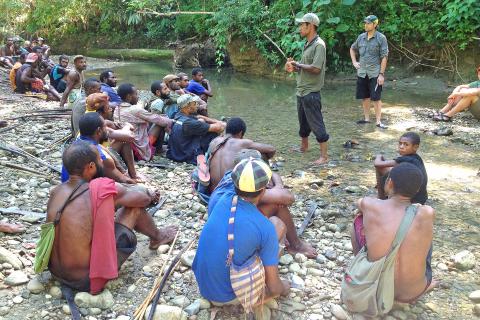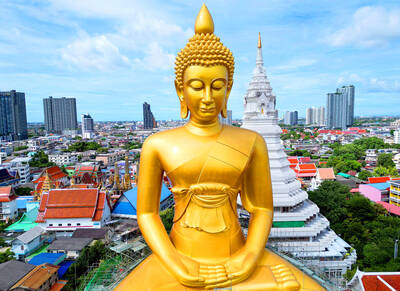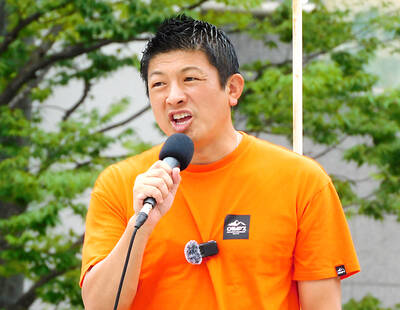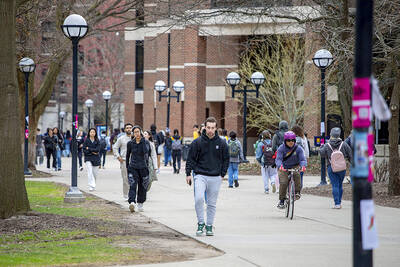A 6,000-year-old skull found in Papua New Guinea is likely the world’s oldest-known tsunami victim, experts said yesterday after a new analysis of the area it was found in.
The partially preserved Aitape skull was discovered in 1929 by Australian geologist Paul Hossfeld, 12km inland from the northern coast of Papua New Guinea.
It was long thought to belong to Homo erectus (upright man), an extinct species thought to be an ancestor of the modern human that died out about 140,000 years ago.

Photo: AFP / UNIVERSITY OF NEW SOUTH WALES / Ethan COCHRANE
However, more recent radiocarbon dating estimated it was closer to 6,000 years old, making it a member of our own species — Homo sapiens. At that time, sea levels were higher and the area would have been near the coast.
An international team led by the University of New South Wales (UNSW) returned to the site to collect the same geological deposits observed by Hossfeld.
Back in the lab, they studied details of the sediment including its grain size and geochemical composition, which can help identify a tsunami inundation.
They also identified a range of microscopic organisms from the ocean in the sediment, similar to those found in soil after a devastating tsunami hit the region in 1998.
“We have discovered that the place where the Aitape skull was unearthed was a coastal lagoon that was inundated by a large tsunami about 6,000 years ago,” study author and UNSW scientist James Goff said. “It was similar to the one that struck nearby with such devastating effect in 1998, killing more than 2,000 people.”
“We conclude that this person who died there so long ago is probably the oldest-known tsunami victim in the world,” Goff said.
The conclusions, aided by researchers from the US, France, New Zealand and Papua New Guinea, were published in the journal PLOS ONE.
Goff, an authority on tsunamis, said while the bones of the skull had been well-studied previously, little attention had been paid to the sediments where they were unearthed.
“The geological similarities between these sediments and the sediments laid down during the 1998 tsunami made us realize that human populations in this area have been affected by these massive inundations for thousands of years,” he said.
“After considering a range of possible scenarios, we believe that, on the balance of the evidence, the individual was either killed directly in the tsunami, or was buried just before it hit and the remains were redeposited,” Goff added.
Following the 1998 tsunami, which penetrated up to 5km inland, attempts to retrieve victims were called off after a week because crocodiles were feeding on the corpses, leading to their dismemberment.
This may also explain why the skull of the person who died 6,000 years ago was found on its own, without any other bones, the researchers said.
Attention has been drawn to the effect of tsunamis in recent decades, particularly following those in Indonesia in 2004 and Japan in 2011, which killed about 230,000 and 16,000 people respectively.
However, research in the Pacific has shown that throughout history and prehistory, the region has seen repeated catastrophic tsunamis that have caused death, abandonment of settlements, breakdown of trading routes and even war, the study said.

IDENTITY: A sex extortion scandal involving Thai monks has deeply shaken public trust in the clergy, with 11 monks implicated in financial misconduct Reverence for the saffron-robed Buddhist monkhood is deeply woven into Thai society, but a sex extortion scandal has besmirched the clergy and left the devout questioning their faith. Thai police this week arrested a woman accused of bedding at least 11 monks in breach of their vows of celibacy, before blackmailing them with thousands of secretly taken photos of their trysts. The monks are said to have paid nearly US$12 million, funneled out of their monasteries, funded by donations from laypeople hoping to increase their merit and prospects for reincarnation. The scandal provoked outrage over hypocrisy in the monkhood, concern that their status

The United States Federal Communications Commission said on Wednesday it plans to adopt rules to bar companies from connecting undersea submarine communication cables to the US that include Chinese technology or equipment. “We have seen submarine cable infrastructure threatened in recent years by foreign adversaries, like China,” FCC Chair Brendan Carr said in a statement. “We are therefore taking action here to guard our submarine cables against foreign adversary ownership, and access as well as cyber and physical threats.” The United States has for years expressed concerns about China’s role in handling network traffic and the potential for espionage. The U.S. has

A disillusioned Japanese electorate feeling the economic pinch goes to the polls today, as a right-wing party promoting a “Japanese first” agenda gains popularity, with fears over foreigners becoming a major election issue. Birthed on YouTube during the COVID-19 pandemic, spreading conspiracy theories about vaccinations and a cabal of global elites, the Sanseito Party has widened its appeal ahead of today’s upper house vote — railing against immigration and dragging rhetoric that was once confined to Japan’s political fringes into the mainstream. Polls show the party might only secure 10 to 15 of the 125 seats up for grabs, but it is

The US Department of Education on Tuesday said it opened a foreign funding investigation into the University of Michigan (UM) while alleging it found “inaccurate and incomplete disclosures” in a review of the university’s foreign reports, after two Chinese scientists linked to the school were separately charged with smuggling biological materials into the US. As part of the investigation, the department asked the university to share, within 30 days, tax records related to foreign funding, a list of foreign gifts, grants and contracts with any foreign source, and other documents, the department said in a statement and in a letter to